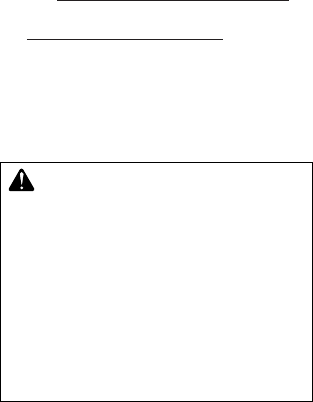
www.fmiproducts.com
125311-01A6
DETERMINING FRESH-AIR FLOW
FOR HEATER LOCATION
Determining if You Have a Conned or
Unconned Space
Use this work sheet to determine if you have
a conned or unconned space.
Space: Includes the room in which you will install
heater plus any adjoining rooms with doorless
passageways or ventilation grills between the
rooms.
1. Determine the volume of the space (length
x width x height).
Length x Width x Height =__________cu. ft.
(volume of space)
Example: Space size 20 ft. (6.1m) (length) x
16 ft. (4.88m) (width) x 8 ft. (2.44 m) (ceiling
height) = 2,560 cu. ft. (72.49 m
2
)(volume of
space)
If additional ventilation to adjoining room
is supplied with grills or openings, add the
volume of these rooms to the total volume
of the space.
2. Multiply the space volume by 20 to determine
the maximum Btu/Hr the space can support.
________ (volume of space) x 20 = (Maxi-
mum Btu/Hr the space can support)
Example: 2,560 cu. ft. (72.49 m
2
) (volume of
space) x 20 = 51,200 (maximum Btu/Hr the
space can support)
3. Add the Btu/Hr of all fuel burning appliances
in the space.
Vent-free heater _________Btu/Hr
Gas water heater* _________Btu/Hr
Gas furnace _________Btu/Hr
Vented gas heater _________Btu/Hr
Gas heater logs _________Btu/Hr
Other gas appliances* + _________ Btu/Hr
Total = _________Btu/Hr
* Do not include direct-vent gas appliances.
Direct-vent draws combustion air from the
outdoors and vents to the outdoors.
Example:
Gas water heater _________Btu/Hr
Vent-free heater + _________Btu/Hr
Total = _________Btu/Hr
4. Compare the maximum Btu/Hr the space
can support with the actual amount of Btu/
Hr used.
_______ Btu/Hr (maximum can support)
_______ Btu/Hr (actual amount used)
Example: 51,200 Btu/Hr (maximum the
space can support)
60,000 Btu/Hr (actual amount of
Btu/Hr used)
AIR FOR COMBUSTION AND VENTILATION
Continued
The space in the example is a conned space
because the actual Btu/Hr used is more than the
maximum Btu/Hr the space can support. You
must provide additional fresh air. Your options
are as follows:
A. Rework worksheet, adding the space of an
adjoining room. If the extra space provides an
unconned space, remove door to adjoining
room or add ventilation grills between rooms.
See Ventilation Air From Inside Building.
B. Vent room directly to the outdoors. See
Ventilation Air From Outdoors, page 7.
C. Install a lower Btu/Hr heater, if lower Btu/Hr
size makes room unconned.
If the actual Btu/Hr used is less than the maxi-
mum Btu/Hr the space can support, the space is
an unconned space. You will need no additional
fresh air ventilation.
WARNING: If the area in which
the heater may be operated does
not meet the required volume for
indoor combustion air, combus-
tion and ventilation air shall be
provided by one of the methods
described in the National Fuel
Gas Code, ANSI Z223.1/NFPA 54,
the International Fuel Gas Code,
or applicable local codes.
VENTILATION AIR
Ventilation Air From Inside Building
This fresh air would come from an adjoining
unconned space. When ventilating to an
adjoining unconned space, you must provide
two permanent openings: one within 12" (30.5
cm) of the ceiling and one within 12" (30.5 cm)
of the oor on the wall connecting the two
spaces (see options 1 and 2, Figure 2, page
7). You can also remove door into adjoining
room (see option 3, Figure 2, page 7). Follow
the National Fuel Gas Code, ANSI Z223.1/
NFPA 54, Air for Combustion and Ventilation
for required size of ventilation grills or ducts.
40,000
60,000
20,000


















